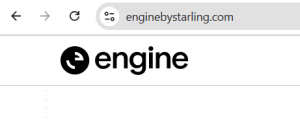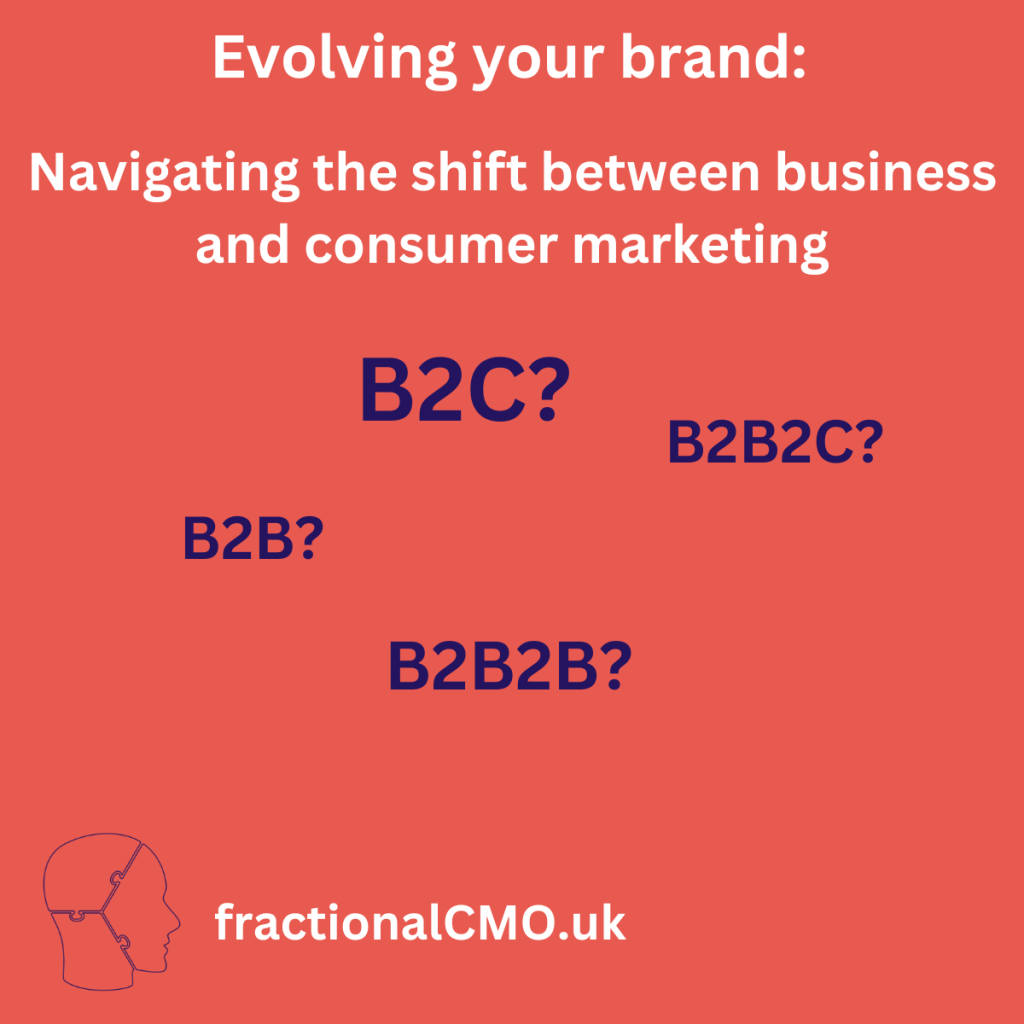Business models evolve – sometimes abruptly.
- A B2B2C brand reaching maturity may decide to look at moving to a D2C model.
- A business selling to the SME market directly may want to reach more customers by looking at a B2B2B model.
- B2C brands may think they can scale by taking on enterprise clients…
It makes sense to look around and consider moving out of your lane and comfort zone. The case can appear compelling – but if you don’t get it right, its could be a recipe for disaster.
I’ve been through a few of these situations myself and have learnt from my mistakes. So can you!
Understand your reasons for expanding into new markets
It seems fairly obvious on the face of it: new markets offer new growth opportunities.
However, there are multiple reasons a business may want to consider expanding from one model to another. Examples include:
- A business is doing well selling through 3rd parties to consumers (B2B2C). It’s a standard route to market and gives access to a potentially broad base of customer.
However, that business is then reliant on it’s partner and inevitably is passing some value to the partner (often in the form of discounts and/or commission).
Launching directly into the B2C space looks attractive – reducing reliance on the partner, potentially finding new customers and realising greater value.- The challenges here include:
- Ensuring you have the right channels to reach the consumer directly (without incurring a significantly higher Customer Acquisition Cost (CAC) on the way)
- Ensuring you don’t undermine your existing partner and lose that important relationship.
- The challenges here include:
- A business selling a product or service into the consumer market (B2C) may feel their product also meets the needs of business customers. This looks juicy as B2B customers (particularly Enterprise customers) could pay significantly more for the product.
- The challenges here might include:
- Getting product market fit in a business environment could be very different to the consumer world.
- Sales and marketing models are very different and timescales significantly longer in the enterprise environment.
- The challenges here might include:
- It’s not always about market share. One of the challenges of working in the B2B2C arena can be that (depending on your model) you may not have direct contact with the end-user. By launching into the direct B2C market, even if only on a small scale, you have a ‘panel’ of customers of your very own. This can be an excellent way to gather valuable data (demographic, usage and attitudinal).
I worked with a B2B SaaS brand a while back who had made reasonable progress selling directly to small businesses. However, their product entry price was relatively low (£tens not £hundreds per month), and the cost of reaching individual customers was getting prohibitively expensive.
Working with the advisors of those end customers makes a lot of sense – so if you’re selling financial services, for example, selling through an Accountant may give you access to dozens if not hundreds of potential customers.
So the business moved to a B2B2B model.
Stepping up a level to the banks or accounting software providers then becomes highly tempting – going from accessing dozens of customers to hundreds of thousands if not millions.
We’ll come back to this example later.
There are also illegitimate reasons for wanting to move markets:
“It didn’t work selling to consumers, so maybe I’ll try businesses instead”
is fraught with danger.
What changes? What stays the same?
From a sales/operations perspective, there is the potential for lots to change.
For example, I worked alongside a social-housing building company (B2B) who were expanding by offering their services directly to homeowners (B2C).
What they expected was a shortened sales process because they were dealing with single stakeholders, rather than large organisations. What they found was they were still dealing with multiple stakeholders such as partners and extended family. And they discovered consumers can sometimes take a long time to make decisions too.
They also found the consumers to be – rightly – demanding when it came to decisions such as the choice of finish for their building work.
In addition, they had to adapt their sales language on a number of levels (such as ensuring technical terms were understood and that consumers were fully informed).
However, my main focus here is to look at the marketing changes required when moving from one market to the other.
Brand identity
When changing markets and deciding whether to
- Keep your brand
- Modify your brand
- Create a sub-brand or
- Create a new brand
Seek professional advice!
Branding can be an expensive game – getting it wrong could spell the difference between success and failure.
Each of the options has pros and cons.
Running one brand across two markets could be confusing – having consumers and business buyers turn-up to the same web page could be disastrous.
But modifying your brand or creating a sub-brand could also confuse the market.
And creating a new brand from scratch can be expensive. And I can’t tell you how many hours (days!) of my life I’ve wasted discussing the potential names for new brands…
Questions to ask yourself include:
- How “good” is my current brand? (Does it resonate with your customers? Is it recognised?)
- Will it be able to address the pain points for the new market?
- Is it flexible enough to address multiple markets at once?
Example of successful brand launch into a new market – Starling Bank:
Consumer challenger bank Starling decided their technology was a potential product in itself, and so they decided to expand from B2C into B2B by launching a new brand.
Engine still maintains something of the look and feel of Starling but is deliberately stripped back (monochrome) to represent the essence of the product – the straight-forward infrastructure that built the bank.
The ‘by Starling’ is important here – reiterating that this is the technology that build an award-winning bank.


It’s important to remember that you will almost certainly maintain some connection between your offerings – so an element of your brand values must be shared between the offerings. You couldn’t get away with telling your consumer market you were environment champions, for example, while promoting burning coal to your business clients.
Messaging and tone of voice
Different audiences respond to different messages.
Personally, I am a big believer that B2B marketing would be better if it appealed more to buyer emotions (I’ve been banging that drum for a looooooong time). However, there are differences between the markets.
You need to understand the language of your new market, the pain points and the tone they will react to best.
If your marketers are adept at creating copy for one market, it will take them time and effort to make the change to the new one.
Customer experience
Customer experience will necessarily change as you move markets – in the B2B world, you may rely more on personal contact, in D2C operations, much more could take place online.
Think carefully about how customer operations, UX, nurturing and retention will work with your new market.
Marketing management – KPIs
KPIs for consumer and business marketing are very different. Similarly, marketing to small businesses requires a different set of metrics to marketing to enterprise clients.
Ensure you understand the valuable metrics, not vanity metrics, and that you are targeting (and rewarding) your teams appropriately.
The DNA stays the same
Internal consistency is key. For example: When you have a successful B2B2C product, the DNA will remain the same when you move to serving consumers directly. It’s the positioning, messaging, delivery and routes to market that will change.
What are the risks of evolving your brand into new markets?
The risks are varied when expanding from one market into another. Be wary of:
- Brand dilution
– if your brands are connected but not aligned, there’s a chance you can weaken the value of the original brand. - Brand confusion
– ensure your customers know which way they’re going (and reassure your current market that you’re not taking attention away from them) - Misaligned sales and marketing teams and priorities
(you thought it was bad already…?) - Overlooking some of the core challenges of the new market
– for example, moving from a B2B to a D2C model may require 7-days-a-week service centres. Moving from a B2C to a B2B model may require more long-term relationship building with your existing clients. - Prioritisation in the business
– are all teams aligned and focused on delivering for both parts of the market long term? That’s not just marketing and sales but product as well.
How to build a brand that resonates with your new audience
Research, research, research.
Validate your assumptions before you plunge into the full ocean of a launch.
Example of a wrong assumption
From the B2B SaaS company I mentioned earlier:
The assumption was that switching from B2B to B2B2B would result in serving the same customers displaying the same behaviour was wrong.
It’s a natural assumption to make – the small business customer would be the same whether they bought direct or came though their bank or accountant.
However, they’re not the same. The motivation for taking the product is different and so the relationship with the product is different.
Specifically in this case, while acquisition became a whole lot easier, activation and engagement became the challenge – and if users don’t activate or engage, they won’t renew.
The fix: comms, and lots of it. We reworked the whole onboarding journey (using email and agents) and implemented a new continual engagement journey.
Who’s done it well?
B2C to B2B
Wise (formerly TransferWise) launched consumer operations in 2011 and expanded to the B2B audience in 2016 – using the same brand.

Procter & Gamble (P&G) are well known consumer brand and home to dozens of product brands. However, a significant portion of its revenue comes from P&G Professional which takes a totally different tone with its market.

B2B to B2C
Zoom – the lockdown hero – until 2020, Zoom was almost unknown in consumer markets, but became a global household name overnight, without launching a new brand.
Adobe – though they use the same overall brand (and they have gone through multiple changes over the years), Adobe’s products were originally aimed at businesses, but through Adobe Creative Cloud now target consumers and freelancers.

And one more example which doesn’t quite fit:
As head of growth at auto-energy switcher Switchd, I was part of the team who launched disruptive solar installer MakeMyHouseGreen. Both are consumer-facing businesses who go to market through both D2C and B2B2C channels.
However, the difference in buying behaviour between a £2.69 per month subscription and a £10,000 investment is huge.
The key to success with Switchd lay in automating customer processes, ensuring acquisition pipelines were highly optimised and focusing on (very) low customer acquisition costs. With MakeMyHouseGreen, while automation and optimisation of pipelines were still important, the requirement to quickly build relationships was paramount.
You can’t build a 1:1 relationship with a customer without understanding their pain points and their emotional drivers.

Other resources you may find helpful:
